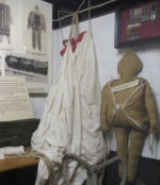
Paradummy
Encyclopedia
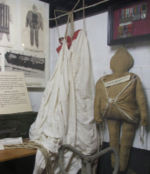
World War II
World War II, or the Second World War , was a global conflict lasting from 1939 to 1945, involving most of the world's nations—including all of the great powers—eventually forming two opposing military alliances: the Allies and the Axis...
that, used with other artificial paratrooper
Paratrooper
Paratroopers are soldiers trained in parachuting and generally operate as part of an airborne force.Paratroopers are used for tactical advantage as they can be inserted into the battlefield from the air, thereby allowing them to be positioned in areas not accessible by land...
units, is meant to cause an invasion by air to appear larger than it actually is. Paradummies can also be used to lure enemy troops into staged ambushes.
German paradummies
The first known use of paradummies was by the Germans during the Battle of the NetherlandsBattle of the Netherlands
The Battle of the Netherlands was part of Case Yellow , the German invasion of the Low Countries and France during World War II. The battle lasted from 10 May 1940 until 14 May 1940 when the main Dutch forces surrendered...
and Belgium in 1940. They used straw-filled puppets that were thrown en masse out of airplanes in order to incite fear and panic among the civilian population. The regular German paratrooper units, the Fallschirmjäger
Fallschirmjäger
are German paratroopers. Together with the Gebirgsjäger they are perceived as the elite infantry units of the German Army....
, were actually much smaller in number. In August of the same year, paradummies were also used over Scotland
Scotland
Scotland is a country that is part of the United Kingdom. Occupying the northern third of the island of Great Britain, it shares a border with England to the south and is bounded by the North Sea to the east, the Atlantic Ocean to the north and west, and the North Channel and Irish Sea to the...
for deceptive purposes. These dummies no longer exist and little is known today about their appearance and other details.
The Luftwaffe
Luftwaffe
Luftwaffe is a generic German term for an air force. It is also the official name for two of the four historic German air forces, the Wehrmacht air arm founded in 1935 and disbanded in 1946; and the current Bundeswehr air arm founded in 1956....
's Fallschirmjäger
Fallschirmjäger
are German paratroopers. Together with the Gebirgsjäger they are perceived as the elite infantry units of the German Army....
used artificial jumpers in later times as well, such as during the Ardennes Offensive, which started in the middle of December 1944. These dummies were so convincing that some American troops rapidly evacuated their positions. Subsequent clarification confirmed only the landing of dummies, as well as the testimony of isolated German soldiers who were taken captive.
To facilitate an even more realistic depiction of a Paratrooper landing, the Luftwaffe
Luftwaffe
Luftwaffe is a generic German term for an air force. It is also the official name for two of the four historic German air forces, the Wehrmacht air arm founded in 1935 and disbanded in 1946; and the current Bundeswehr air arm founded in 1956....
was believed to have experimented with smoke bombs attached to the feet of the dummies as a way of simulating kicked-up dust. These modified dummies, however, were never used.
British paradummies
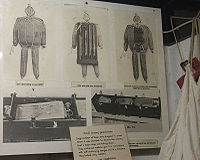
In 1942 the Paradummies served as a distraction to the British invasion of Madagascar, which at the time was administered by France's Vichy Government. The dummies used during Operation Ironclad roughly resembled those dropped at night in Normandy on D-Day
D-Day
D-Day is a term often used in military parlance to denote the day on which a combat attack or operation is to be initiated. "D-Day" often represents a variable, designating the day upon which some significant event will occur or has occurred; see Military designation of days and hours for similar...
. Little if anything is known about dummies created before 1942 as they are no longer in existence.
Operation Titanic
The paradummy drop over Normandy Operation TitanicOperation Titanic
Operation Titanic was the codename for an operation carried out on 5-6 June 1944 by the Royal Air Force and the Special Air Service in support of the Normandy landings during the Second World War...
is probably the best known operation of its kind. In the early hours of the morning of June 6, 1944 a force of 40 Hudsons
Lockheed Hudson
The Lockheed Hudson was an American-built light bomber and coastal reconnaissance aircraft built initially for the Royal Air Force shortly before the outbreak of the Second World War and primarily operated by the RAF thereafter...
, Halifaxes
Handley Page Halifax
The Handley Page Halifax was one of the British front-line, four-engined heavy bombers of the Royal Air Force during the Second World War. A contemporary of the famous Avro Lancaster, the Halifax remained in service until the end of the war, performing a variety of duties in addition to bombing...
and Stirlings
Short Stirling
The Short Stirling was the first four-engined British heavy bomber of the Second World War. The Stirling was designed and built by Short Brothers to an Air Ministry specification from 1936, and entered service in 1941...
dropped a total of 500 dummies in four separate locations along the coastal interior. Window
Chaff (radar countermeasure)
Chaff, originally called Window by the British, and Düppel by the Second World War era German Luftwaffe , is a radar countermeasure in which aircraft or other targets spread a cloud of small, thin pieces of aluminium, metallized glass fibre or plastic, which either appears as a cluster of secondary...
, rifle fire simulators and two teams of Special Air Service
Special Air Service
Special Air Service or SAS is a corps of the British Army constituted on 31 May 1950. They are part of the United Kingdom Special Forces and have served as a model for the special forces of many other countries all over the world...
soldiers carrying recordings of loud battle noise were also dropped to reinforce the deception and divert German troops away from the Allies' actual drop zones. The dummies were nicknamed Rupert and were fabricated with sack cloth/burlap representations of a human figure stuffed with straw or sand and not the highly elaborate and lifelike rubber dummies suggested in some accounts and portrayed in the film The Longest Day
The Longest Day (film)
The Longest Day is a 1962 war film based on the 1959 history book The Longest Day by Cornelius Ryan, about "D-Day", the Normandy landings on 6 June 1944, during World War II....
. They were equipped with an explosive charge that burned away the cloth after landing to prevent the immediate discovery of their true nature. Two Stirling aircraft were lost in the operation and of the six SAS soldiers involved, only two eventually reached safety, the others were captured and remained in German POW camps until the end of the war.
A few of the original dummies are now displayed in war museums. In the 1980s, several more dummies were found in the hangar of an old airfield in Great Britain. They have frequently been offered in auctions and on the Internet.
American paradummies
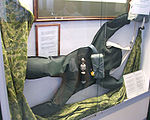
Academy Awards
An Academy Award, also known as an Oscar, is an accolade bestowed by the American Academy of Motion Picture Arts and Sciences to recognize excellence of professionals in the film industry, including directors, actors, and writers...
statues. The actor Douglas Fairbanks Jr., who served as a lieutenant in the navy, was directly involved in the development and design of these dummies. It is believed that he brought the idea with him from Great Britain, where he was stationed for a time. In early March 1943, the test flight with several of these paradummies took place at an airfield near the coast of Chesapeake Bay. The Paradummies were dropped by a TBF Avenger plane over the coast and airfield. Three observation groups standing at various distances shared in writing their impressions with the navy. A few of them had been intentionally left unaware that dummies had been dropped - they were simply told to report on what they saw. The reports stated that the dummies proved defective since they were too small and had no moving parts that might move during the drop which reduced their effectiveness. The observers mostly felt the dummies looked unrealistic.
As a result of this test, the US Navy at Lakehurst
Lakehurst
There are a number of places named Lakehurst:*Lakehurst, New Jersey.*Lakehurst High School, a fictional school in Degrassi: The Next Generation*Lakehurst Mall, a defunct shopping complex in Waukegan, Illinois...
developed larger, inflatable dummies made of rubberized material, the so-called PD-Packs. The PD-Packs were used in southern France and the Philippines.
Another use of artificial Paratroopers by Americans in the Second World War took place over New Guinea during a jump of the 503rd Infantry Regiment. It is believed these were the rubber dummies. In the 1950s, the US Army further developed the "Oscar" paradummy variation. This development led to an easy-to-transport, foldable dummy whose head and boots were made of plaster. The dummies now also wore realistic fabric uniforms. The new type was used during missions in Korea.
Other uses for paradummies
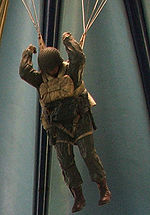
Vietnam War
The Vietnam War was a Cold War-era military conflict that occurred in Vietnam, Laos, and Cambodia from 1 November 1955 to the fall of Saigon on 30 April 1975. This war followed the First Indochina War and was fought between North Vietnam, supported by its communist allies, and the government of...
, the Americans dropped leftover dummies over Vietcong outposts and in their vicinity. This served to lure the North Vietnamese
North Vietnam
The Democratic Republic of Vietnam , was a communist state that ruled the northern half of Vietnam from 1954 until 1976 following the Geneva Conference and laid claim to all of Vietnam from 1945 to 1954 during the First Indochina War, during which they controlled pockets of territory throughout...
into staged ambushes, where they could be attacked with air power. Other covert operations used blocks of ice instead of dummies, which would melt in the hot Vietnamese weather before Communist forces could arrive. The parachutes would be left and found in the drop zones and lead them to believe that American troops were still operating in the area.
The modern American paradummies are made of PVC
Polyvinyl chloride
Polyvinyl chloride, commonly abbreviated PVC, is a thermoplastic polymer. It is a vinyl polymer constructed of repeating vinyl groups having one hydrogen replaced by chloride. Polyvinyl chloride is the third most widely produced plastic, after polyethylene and polypropylene. PVC is widely used in...
and look like GI-dummies, but they are larger than the dummies of the 1950s. During the Gulf War
Gulf War
The Persian Gulf War , commonly referred to as simply the Gulf War, was a war waged by a U.N.-authorized coalition force from 34 nations led by the United States, against Iraq in response to Iraq's invasion and annexation of Kuwait.The war is also known under other names, such as the First Gulf...
, special forces implemented these dummies to distract Iraqi troops. They have also been used in Afghanistan.
The Americans also use paradummies during exercises to simulate larger paratrooper invasions.
Further reading
- Jon Latimer, Deception in War, London: John Murray, 2001 ISBN 0-7195-5605-8

